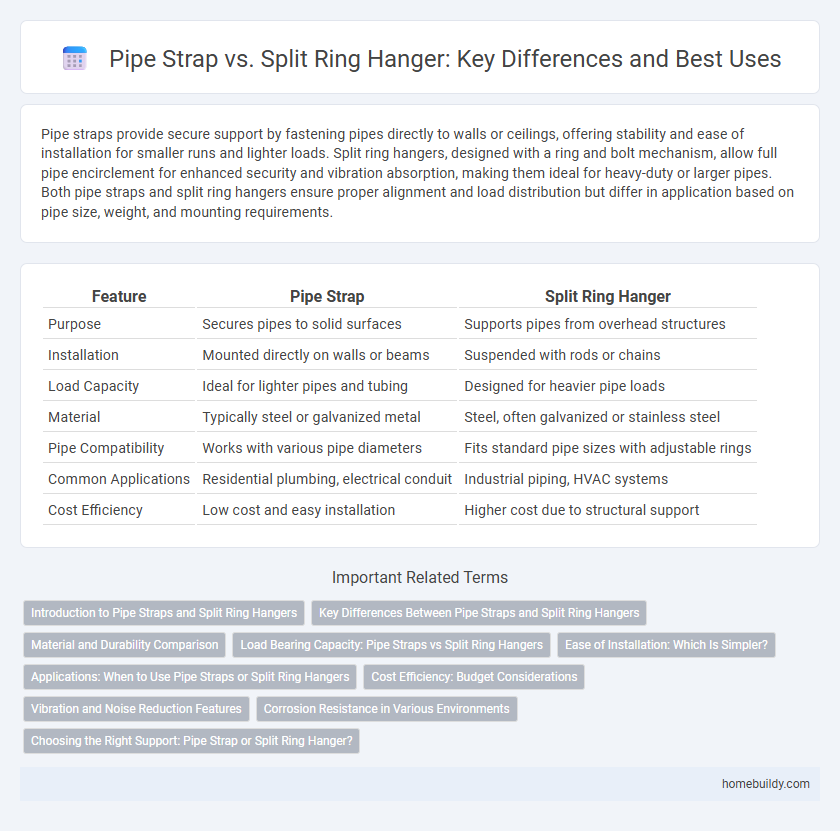Pipe straps provide secure support by fastening pipes directly to walls or ceilings, offering stability and ease of installation for smaller runs and lighter loads. Split ring hangers, designed with a ring and bolt mechanism, allow full pipe encirclement for enhanced security and vibration absorption, making them ideal for heavy-duty or larger pipes. Both pipe straps and split ring hangers ensure proper alignment and load distribution but differ in application based on pipe size, weight, and mounting requirements.
Table of Comparison
| Feature | Pipe Strap | Split Ring Hanger |
|---|---|---|
| Purpose | Secures pipes to solid surfaces | Supports pipes from overhead structures |
| Installation | Mounted directly on walls or beams | Suspended with rods or chains |
| Load Capacity | Ideal for lighter pipes and tubing | Designed for heavier pipe loads |
| Material | Typically steel or galvanized metal | Steel, often galvanized or stainless steel |
| Pipe Compatibility | Works with various pipe diameters | Fits standard pipe sizes with adjustable rings |
| Common Applications | Residential plumbing, electrical conduit | Industrial piping, HVAC systems |
| Cost Efficiency | Low cost and easy installation | Higher cost due to structural support |
Introduction to Pipe Straps and Split Ring Hangers
Pipe straps are sturdy metal or plastic fasteners designed to secure pipes to walls or ceilings, providing reliable support and preventing movement. Split ring hangers, featuring a circular split design with a threaded rod attachment, offer enhanced stability by cradling pipes while allowing for easy height adjustments. While pipe straps are ideal for fixed mounting, split ring hangers excel in applications requiring suspension and load distribution for heavier piping systems.
Key Differences Between Pipe Straps and Split Ring Hangers
Pipe straps secure pipes directly against surfaces, providing stability and preventing movement, while split ring hangers suspend pipes with cushioning to reduce vibration and noise. Pipe straps are typically simpler and more cost-effective for rigid installations, whereas split ring hangers offer enhanced support for heavier pipes and allow easier access for maintenance. The choice depends on load requirements, installation environment, and the need for vibration isolation.
Material and Durability Comparison
Pipe straps are typically made from galvanized steel or stainless steel, providing excellent corrosion resistance and long-lasting durability in various environmental conditions. Split ring hangers, often constructed from carbon steel with protective coatings, offer robust structural support but may be more prone to rust if coatings degrade over time. When comparing materials and durability, pipe straps generally excel in environments requiring minimal maintenance, while split ring hangers deliver superior stability in heavy-load applications but may require more upkeep to prevent corrosion.
Load Bearing Capacity: Pipe Straps vs Split Ring Hangers
Pipe straps generally offer lower load bearing capacity compared to split ring hangers, making them suitable for lighter pipe installations. Split ring hangers provide superior support and stability due to their robust design, allowing them to handle heavier loads and larger pipe diameters effectively. Engineers often prefer split ring hangers in environments where high load capacity and vibration resistance are critical factors.
Ease of Installation: Which Is Simpler?
Pipe straps offer a straightforward installation process by securely fastening pipes to surfaces using screws or nails, making them ideal for quick, reliable support. Split ring hangers require additional components like bolts and nuts, which can complicate the setup and extend installation time. For ease of installation, pipe straps are generally simpler and more efficient in typical plumbing and electrical applications.
Applications: When to Use Pipe Straps or Split Ring Hangers
Pipe straps are ideal for securing pipes to walls or ceilings where minimal movement occurs, commonly used in residential plumbing and electrical conduit installations. Split ring hangers provide superior support for heavier pipes requiring vertical suspension, frequently utilized in commercial and industrial piping systems. Selecting between pipe straps and split ring hangers depends on load requirements, pipe size, and whether the installation demands rigid or flexible support.
Cost Efficiency: Budget Considerations
Pipe straps offer a more cost-efficient solution compared to split ring hangers, as their simpler design reduces material and installation expenses. Split ring hangers, while providing superior load support, generally incur higher costs due to complex manufacturing and additional hardware requirements. For budget-conscious projects, pipe straps provide effective pipe securing with minimized expenditure without compromising basic functionality.
Vibration and Noise Reduction Features
Pipe straps provide a secure grip on pipes but offer limited vibration and noise reduction compared to split ring hangers, which incorporate a split ring design that cushions pipe movement and absorbs vibrations effectively. Split ring hangers are often lined with neoprene or other sound-dampening materials, significantly minimizing noise transmission in plumbing and HVAC systems. Their capability to reduce mechanical noise and vibration makes split ring hangers the preferred choice for sensitive environments requiring enhanced acoustic performance.
Corrosion Resistance in Various Environments
Pipe straps and split ring hangers differ significantly in corrosion resistance when exposed to various environments; pipe straps are often fabricated from galvanized steel or stainless steel, providing superior protection against rust and oxidation in humid or outdoor settings. Split ring hangers, typically made from carbon steel with protective coatings, may be more susceptible to corrosion in highly acidic or marine environments without additional treatments. Selecting the appropriate material and finish for either option is crucial to ensuring long-term durability and performance in corrosive conditions.
Choosing the Right Support: Pipe Strap or Split Ring Hanger?
Pipe straps provide a secure and economical method for fastening pipes directly to surfaces, ideal for light to moderate load applications. Split ring hangers offer enhanced stability and vibration resistance, making them suitable for heavier pipe systems requiring precise alignment. Selecting the right support depends on pipe size, load requirements, and installation environment to ensure long-term durability and safety.
Pipe strap vs Split ring hanger Infographic

 homebuildy.com
homebuildy.com